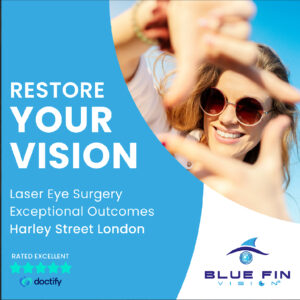When it comes to vision correction, many people automatically think of LASIK surgery. While LASIK is a great option for many, it isn’t the best choice for everyone. For individuals with severe refractive errors, or those over a certain age experiencing presbyopia or cataracts, there is an alternative that might offer a more effective and lasting solution: Refractive Lens Exchange (RLE).
Refractive Lens Exchange is a surgical procedure where the eye’s natural lens is removed and replaced with an artificial intraocular lens (IOL). This is similar to cataract surgery but is performed for the purpose of correcting refractive vision problems such as nearsightedness (myopia), farsightedness (hyperopia), and presbyopia, rather than due to cataracts. By replacing the eye’s lens, RLE can provide a permanent correction to vision issues, offering an alternative for those who are not ideal candidates for LASIK.
One of the key advantages of RLE over LASIK is its ability to address a broader range of vision problems, especially in individuals with severe refractive errors. LASIK is effective for moderate levels of nearsightedness, farsightedness, and astigmatism, but when the refractive error is too high, LASIK might not offer the best results. This is where RLE shines. It is capable of treating extreme cases of nearsightedness and farsightedness, something LASIK cannot always correct due to its limitations on corneal reshaping. Additionally, RLE offers an effective solution for presbyopia, the condition that typically affects people over the age of 40, making it harder to focus on nearby objects.
The procedure itself is relatively quick and minimally Refractive lens exchange invasive. The surgeon begins by making a tiny incision in the cornea to access the natural lens. The lens is then carefully removed, and a custom intraocular lens is inserted. The IOL can be tailored to correct the specific refractive error and, in the case of presbyopia, to allow the patient to see at different distances without glasses. This could mean no longer needing reading glasses or bifocals. Depending on the type of lens used, patients could see improvements in both near and far vision.

For many, the appeal of RLE lies in the permanence of the results. Once the artificial lens is inserted, it is designed to last a lifetime, unlike glasses or contact lenses that require regular updates and maintenance. The visual freedom that comes with no longer needing corrective eyewear is a game-changer for many people, especially those who have worn glasses or contacts for most of their lives.
RLE is also an excellent option for individuals experiencing cataracts. Cataracts, the clouding of the natural lens due to aging, can cause blurry vision and difficulty seeing in low-light conditions. While cataract surgery typically addresses the removal of the cloudy lens, RLE can do the same while also correcting refractive errors. If you already have cataracts and are considering surgery, RLE can solve both issues in one procedure, eliminating the need for glasses or contacts afterward.
Despite its advantages, RLE is not without potential risks, which include infection, inflammation, or issues with the IOL, such as dislocation or improper alignment. Patients may also experience glare, halos around lights, or a temporary adjustment period as the eye heals. These risks can be minimized by choosing an experienced surgeon and carefully following pre- and post-operative instructions.
In terms of recovery, RLE patients typically experience a quick recovery time. Many people report improved vision within a few days, and most can return to their normal activities within a week or so. However, it can take several weeks for full vision stabilization, and some patients may need time to adjust to the new lenses, especially when it comes to focusing at different distances.
In conclusion, Refractive Lens Exchange is a transformative procedure that offers a lasting solution for those seeking clear, reliable vision. It can be the ideal choice for patients who are not candidates for LASIK, have extreme refractive errors, or are experiencing age-related vision changes. With RLE, individuals can regain the freedom from glasses or contacts, enhancing their quality of life. As technology continues to advance, the benefits and popularity of this surgery are likely to grow, making it an increasingly sought-after option for vision correction.